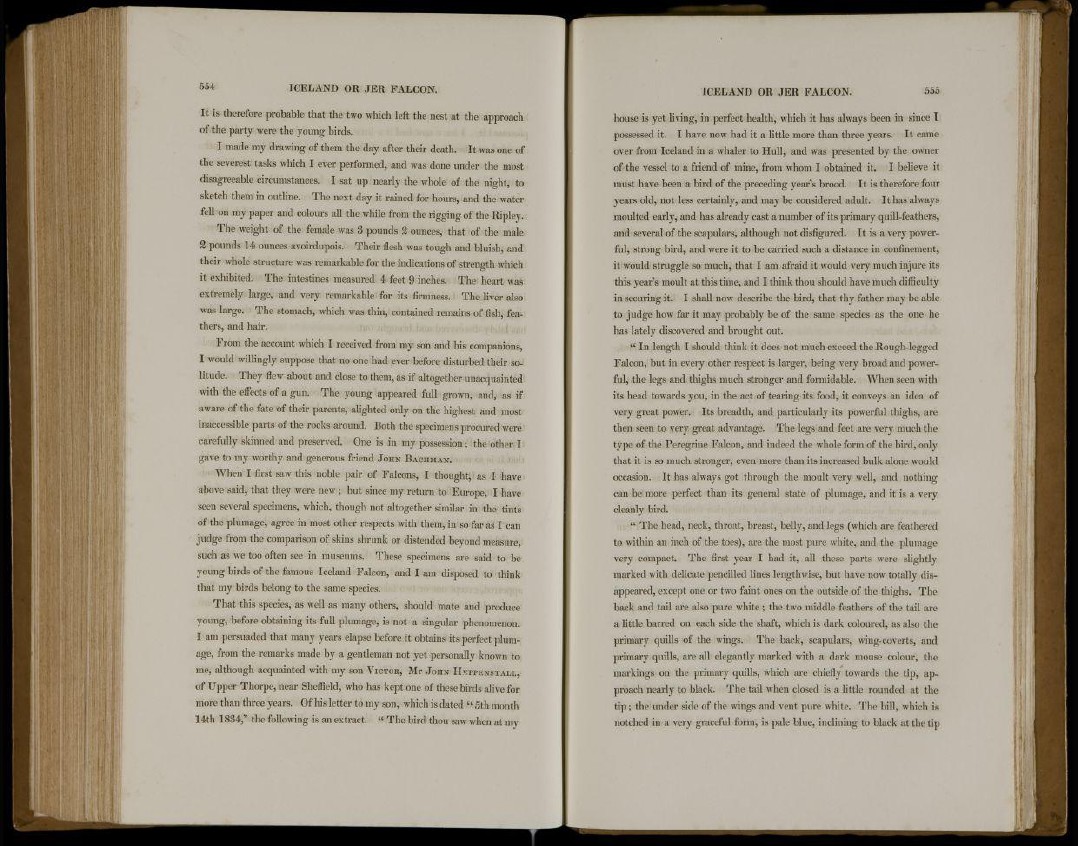
It is therefore probable that the two which left the nest at the approach
of the party were the young birds.
I made my drawing of them the day after their death. It was one of
the severest tasks which I ever performed, and was done under the most
disagreeable circumstances. I sat up nearly the whole of the night, to
sketch them in outline. The next day it rained for hours, and the water
fell on my paper and colours all the while from the rigging of the Ripley.
The weight of the female was 3 pounds 2 ounces, that of the male
2 pounds 14 ounces avoirdupois. Their flesh was tough and bluish, and
their whole structure was remarkable for the indications of strength which
it exhibited. The intestines measured 4 feet 9 inches. The heart was
extremely large, and very remarkable for its firmness. The liver also
was large. The stomach, which was thin, contained remains of fish, feathers,
and hair.
From the account which I received from my son and his companions,
I would willingly suppose that no one had ever before disturbed their solitude.
They flew about and close to them, as if altogether unacquainted
with the effects of a gun. The young appeared full grown, and, as if
aware of the fate of their parents, alighted only on the highest and most
inaccessible parts of the rocks around. Both the specimens procured were
carefully skinned and preserved. One is in my possession; the other I
gave to my worthy and generous friend JOHN BACHMAN.
When I first saw this noble pair of Falcons, I thought, as I have
above said, that they were new; but since my return to Europe, I have
seen several specimens, which, though not altogether similar in the tints
of the plumage, agree in most other respects with them, in so far as I can
judge from the comparison of skins shrunk or distended beyond measure,
such as we too often see in museums. These specimens are said to be
young birds of the famous Iceland Falcon, and I am disposed to think
that my birds belong to the same species.
That this species, as well as many others, should mate and produce
young, before obtaining its full plumage, is not a singular phenomenon.
I am persuaded that many years elapse before it obtains its perfect plumage,
from the remarks made by a gentleman not yet personally known to
me, although acquainted with my son VICTOR, Mr JOHN HEPPENSTALL,
of Upper Thorpe, near Sheffield, who has kept one of these birds alive for
more than three years. Of his letter to my son, which is dated " 5th month
14th 1834," the following is an extract. " The bird thou saw when at my
house is yet living, in perfect health, which it has always been in since I
possessed it. I have now had it a little more than three years. It came
over from Iceland in a whaler to Hull, and was presented by the owner
of the vessel to a friend of mine, from whom I obtained it. I believe it
must have been a bird of the preceding year's brood. It is therefore four
years old, not less certainly, and may be considered adult. It has always
moulted early, and has already cast a number of its primary quill-feathers,
and several of the scapulars, although not disfigured. It is a very powerful,
strong bird, and were it to be carried such a distance in confinement,
it would struggle so much, that I am afraid it would very much injure its
this year's moult at this time, and I think thou should have much difficulty
in securing it. I shall now describe the bird, that thy father may be able
to judge how far it may probably be of the same species as the one he
has lately discovered and brought out.
" In length I should think it does not much exceed the Rough-legged
Falcon, but in every other respect is larger, being very broad and powerful,
the legs and thighs much stronger and formidable. When seen with
its head towards you, in the act of tearing its food, it conveys an idea of
very great power. Its breadth, and particularly its powerful thighs, are
then seen to very great advantage. The legs and feet are very much the
type of the Peregrine Falcon, and indeed the whole form of the bird, only
that it is so much stronger, even more than its increased bulk alone would
occasion. It has always got through the moult very well, and nothing
can be more perfect than its general state of plumage, and it is a very
cleanly bird.
" The head, neck, throat, breast, belly, and legs (which are feathered
to within an inch of the toes), are the most pure white, and the plumage
very compact. The first year I had it, all these parts were slightly
marked with delicate pencilled lines lengthwise, but have now totally disappeared,
except one or two faint ones on the outside of the thighs. The
back and tail are also pure white; the two middle feathers of the tail are
a little barred on each side the shaft, which is dark coloured, as also the
primary quills of the wings. The back, scapulars, wing-coverts, and
primary quills, are all elegantly marked with a dark mouse colour, the
markings on the primary quills, which are chiefly towards the tip, approach
nearly to black. The tail when closed is a little rounded at the
tip; the under side of the wings and vent pure white. The bill, which is
notched in a very graceful form, is pale blue, inclining to black at the tip